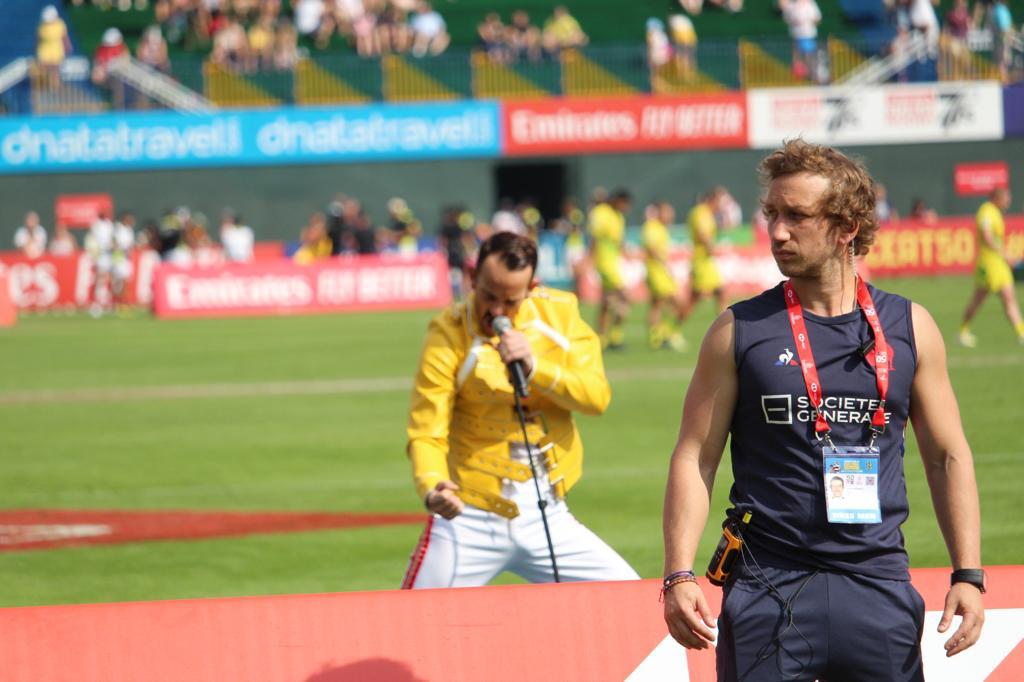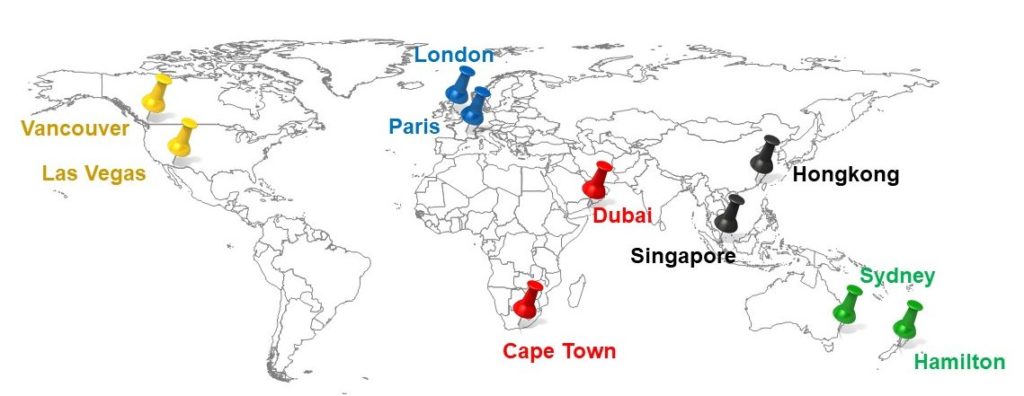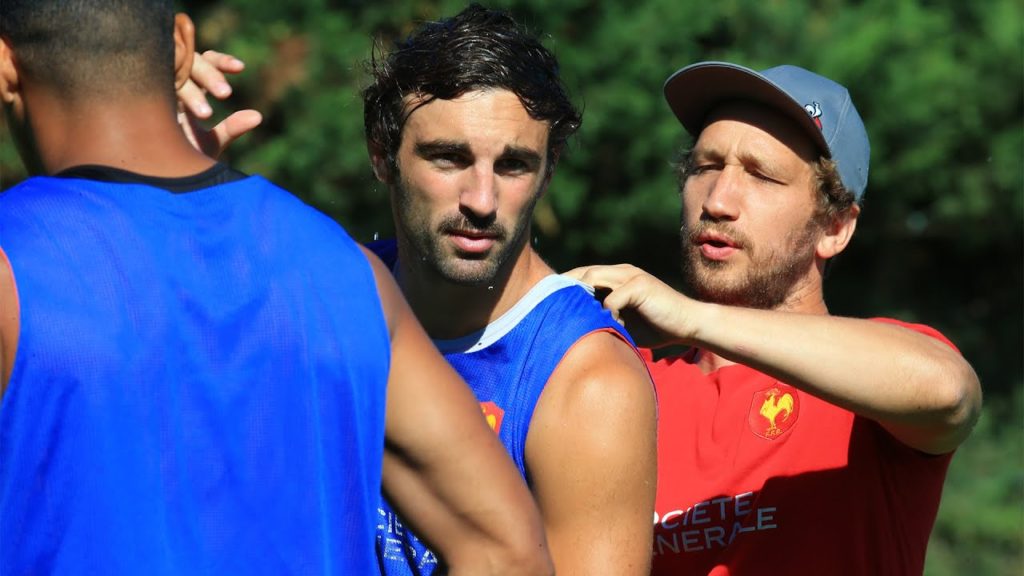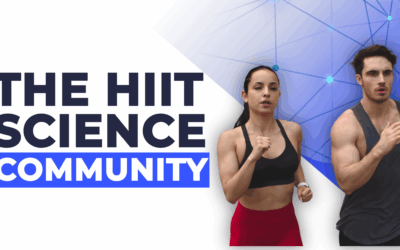 Julien Robineau (right in picture) is the S&C coach for the French male rugby sevens team and is one of the lecturers for our Rugby 7’s course. In addition to his field-based duties, Julien is also an applied researcher, who obtained his PhD in 2013 in the area of concurrent training optimization in rugby players.
We had the chance to catch-up with Julien’s latest, which covered topics as diverse as the unique competition demands of Rugby sevens, as well as some insight into how HIIT can be used effectively in the Rugby sevens context.
HIIT Science: How was training affected by the COVID-19 lockdown?
Julien Robineau (JR): It was brutal! A few days after coming back from Vancouver (one of the HSBC world series tournaments), the lockdown was announced in France (i.e. mid-March). During this period, players were furloughed. Consequently, I couldn’t interact with them or create an S&C program due to the French work policy. It was a mess. But with their training experience, players kept training as best as they could. After 2 months, we were allowed to get in touch with the players again, and the first thing we did was a diagnostic covering what they had completed from a training standpoint using an online questionnaire. Interestingly, their training was mainly related to their current location. While players based in the countryside trained pretty well, those located in cities did not.
HIIT Science: What are the next steps for your team now?
JR: At the moment (the interview was made at the beginning of June), players have already been performing an individual home-based program. At the start of July, we’ll restart team training for a couple of weeks, followed by another period of holidays imposed by French work policy. We expect to restart our normal preseason at the beginning of August. However, we still do not have any idea about the fixture for the next season.
HIIT Science: Let’s talk about Rugby sevens! Could you tell us a bit more about Rugby sevens and its physiological demands?
JR: When we speak about physiological demands in Rugby sevens, we need to understand the global picture first. Indeed, compared to Rugby Union, Rugby sevens fixtures are very different. The male HSBC World Series consists of five competition legs consisting of two tournaments interspersed by one week. Each leg is played on a different continent, separated by just four weeks. A tournament itself is composed of five to six games over the course of two to three days, where each game is interspersed by 2-4 hours. Consequently, this requires us to consider the whole picture when we think about physiological contributions. Indeed, this particular format induces different question for us, such as match preparation, warm-up, recovery across different time scales, travel (we recently published a paper about this topic) and so on.
Julien Robineau (right in picture) is the S&C coach for the French male rugby sevens team and is one of the lecturers for our Rugby 7’s course. In addition to his field-based duties, Julien is also an applied researcher, who obtained his PhD in 2013 in the area of concurrent training optimization in rugby players.
We had the chance to catch-up with Julien’s latest, which covered topics as diverse as the unique competition demands of Rugby sevens, as well as some insight into how HIIT can be used effectively in the Rugby sevens context.
HIIT Science: How was training affected by the COVID-19 lockdown?
Julien Robineau (JR): It was brutal! A few days after coming back from Vancouver (one of the HSBC world series tournaments), the lockdown was announced in France (i.e. mid-March). During this period, players were furloughed. Consequently, I couldn’t interact with them or create an S&C program due to the French work policy. It was a mess. But with their training experience, players kept training as best as they could. After 2 months, we were allowed to get in touch with the players again, and the first thing we did was a diagnostic covering what they had completed from a training standpoint using an online questionnaire. Interestingly, their training was mainly related to their current location. While players based in the countryside trained pretty well, those located in cities did not.
HIIT Science: What are the next steps for your team now?
JR: At the moment (the interview was made at the beginning of June), players have already been performing an individual home-based program. At the start of July, we’ll restart team training for a couple of weeks, followed by another period of holidays imposed by French work policy. We expect to restart our normal preseason at the beginning of August. However, we still do not have any idea about the fixture for the next season.
HIIT Science: Let’s talk about Rugby sevens! Could you tell us a bit more about Rugby sevens and its physiological demands?
JR: When we speak about physiological demands in Rugby sevens, we need to understand the global picture first. Indeed, compared to Rugby Union, Rugby sevens fixtures are very different. The male HSBC World Series consists of five competition legs consisting of two tournaments interspersed by one week. Each leg is played on a different continent, separated by just four weeks. A tournament itself is composed of five to six games over the course of two to three days, where each game is interspersed by 2-4 hours. Consequently, this requires us to consider the whole picture when we think about physiological contributions. Indeed, this particular format induces different question for us, such as match preparation, warm-up, recovery across different time scales, travel (we recently published a paper about this topic) and so on.
 Figure 1. Rugby sevens fixture. The matching colours correspond to one leg where tournaments are interspersed by one week. Each is separated by 4 to 6 weeks.
Figure 1. Rugby sevens fixture. The matching colours correspond to one leg where tournaments are interspersed by one week. Each is separated by 4 to 6 weeks.
HIIT Science: How do you manipulate physiological responses to HIIT sessions? JR: It is an important part of the job because these manipulations allow us to align with the desired physiological target of our sessions or training blocks (as shown in the figure below).Camp d’entraînement qui se termine fort 💥💪🏼 avec une belle séance énergétique pour #France7 🇫🇷 @FranceRugby #lactique #HIIT @hiitscience @Marvin_Oconnor @SachaValleau @terrybouhraoua Merci @staderochelais pour leur accueil et les échanges avec les joueurs et staff 🏉 🟡⚫️ pic.twitter.com/XT1DobVs70
— Julien Robineau (@JulienRobineau) February 21, 2020

Figure 2. Key structural and metabolic targets of importance with HIIT, including the aerobic oxidative system, the anaerobic glycolytic system, and the neuromuscular system.
First, it can be easily done by adjusting the training load related to the session by manipulating the total volume of the session. As we know, the intensity and recovery allow us to target either more aerobic or anaerobic demands. Due to the high running demands related to rugby sevens training we have also an important focus on the neuromuscular load related to the session. For example, if we observe at the end of the week through our monitoring process that players are experiencing serious DOMS, we will adapt the session by decreasing the number of changes of direction or the number sprints. Likewise, we can completely switch the plan and propose off-feet conditioning or even a swimming session in order to decrease this neuromuscular strain. HIIT Science: How do you balance game-based-HIIT and other HIIT weapons? JR: Once again it will depend mainly on the period of the season. The proportion is more in favour of formal HIIT Weapons at the start and we move toward more small-sided games as we approach the competitive period. In season, it is exclusively a small-sided games approach with individual top-ups as necessary. HIIT Science: Tactical periodization: How do you align physical, technical and tactical content with coaches? JR: It is an important point and in fact crucial. It is very important to make the sessions blend seamlessly. Indeed, while the tactical content must be appropriate for this specific period, it might not be the case for some of the physiological aspects. This is where working as a staff is very important. Here, my main input will be to guide and advise concerning the variables (number of players, pitch size, contact or not), which may affect the physiological responses – this is done in alignment with the present physiological objectives. HIIT Science: Random question… is there any particular HIIT session throughout your S&C carer that you remember vividly? JR: Hahaha… this is a tough one as there are so many! If I have to choose, it would be the following. It was just before the first tournament of the season in Dubai 2019-2020. It was a session in the environmental chamber with the whole team. We reproduced similar conditions as Dubai (40°C), and did 3 blocks of 5*6sec sprints on the bike interspersed randomly with long sprints (30 sec). While nothing may be considered out of the ordinary compared with the usual session, we decided to display video highlights across the former season, and this was a game changer! In fact, players were so excited to view their previous season that it made the session unbelievable, with full commitment, great team support, good fun and massive intensity. Perhaps motivation and other psychological aspects for some variables are not manipulated enough in our practice. HIIT Science: How do you monitor training load? JR: Like most of my colleagues around the world, I use GPS technology to gain a global overview concerning the external load. Regarding internal load, RPE is a must I feel, as it allows inclusion of gym work. I used to use many different monitoring tools to assess the response to the load (CMJ, CPK, sleep etc). However, I have since reduced drastically the number of methods employed due to the burden of it all, and the lack of player buy-in sometimes. I’m using a wellness questionnaire on a weekly or fortnightly basis. On top of that, I make sure I maintain a regular chat with each player throughout the week. Additionally, I have an assistant sport scientist (Nicolas Lopez) who helps me a lot, and I could not do the job without him. HIIT Science: Do you consider any non-training interferences?
JR: Yes, we do. It is something we neglected in the past but the further we go, the more we notice its importance. Based on the fixture, we could be qualified as a “sport nomad”. Indeed, we are away more than 6 months per year, and even more so when it is Olympics or world cup time. This can affect some players who are far from their families and this need to be considered in our context. Consequently, we try to give our players as much time with their family as we can. To achieve that, we provide more and more home-based programs in order to keep them in shape, and it seems we have a good buy-in from the team. Another point we consider is what we refer to as the “double project “(combined academic and sport career). Some of our players follow such pathways and need to be guided, or need additional support. From an S&C/training perspective, this can be achieved through small adjustments in the program (individual session, recovery).
HIIT Science: We would like to thank Julien for his time, insight and thorough answers. If you want to follow his work, check out some of the useful links below:
Twitter: https://twitter.com/JulienRobineau
ResearchGate: https://www.researchgate.net/profile/Julien_Robineau2
Online course: The Application of High-Intensity Interval Training for Rugby 7s
HIIT Science: Do you consider any non-training interferences?
JR: Yes, we do. It is something we neglected in the past but the further we go, the more we notice its importance. Based on the fixture, we could be qualified as a “sport nomad”. Indeed, we are away more than 6 months per year, and even more so when it is Olympics or world cup time. This can affect some players who are far from their families and this need to be considered in our context. Consequently, we try to give our players as much time with their family as we can. To achieve that, we provide more and more home-based programs in order to keep them in shape, and it seems we have a good buy-in from the team. Another point we consider is what we refer to as the “double project “(combined academic and sport career). Some of our players follow such pathways and need to be guided, or need additional support. From an S&C/training perspective, this can be achieved through small adjustments in the program (individual session, recovery).
HIIT Science: We would like to thank Julien for his time, insight and thorough answers. If you want to follow his work, check out some of the useful links below:
Twitter: https://twitter.com/JulienRobineau
ResearchGate: https://www.researchgate.net/profile/Julien_Robineau2
Online course: The Application of High-Intensity Interval Training for Rugby 7s





